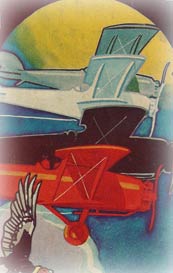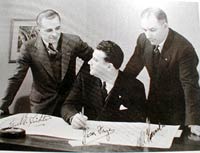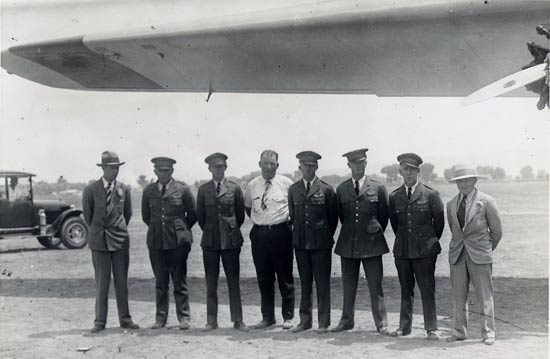|
Jack Frye was a frequent visitor to the Davis-Monthan Airfield.
He landed here 22 times between 1926 and 1929. He was born
on March 18, 1904 in Texas. Before, during and after his travels
to Tucson, he led a grand life in aviation. Check this link
to verify this, and to see family pictures.
In 1921, he enlisted in the U.S. Army and was discharged
the following year as a corporal. He joined the reserves,
and in 1925 was commissioned as 2nd lieutenant in the Air
Corps Reserve. He earned Transport pilot certificate #933, and held
pilot’s license #1 in the state of Arizona. He was an
air transport pioneer, founding Standard
Air Lines. He was also a pilot of the line, which is what
brought him to Tucson 21 times between 1926 and 1929.
His record of landings at the Airfield include four different makes of aircraft as follows:
Standard Air Lines began in Los Angeles, CA as a subsidiary
of Aero Corporation of California, which was formed in 1926
by William John “Jack” Frye (center in photo)
and two associates (Paul
E. Richter, left and Walter Hamilton). Richter and Hamilton
were not only co-founders with Frye of Aero Corp. and Standard
Airlines. Informally known as the "Three Musketeers",
they maintained a career-long work and social bond, forming
TWA during the 1930s and setting the specifications and standards
for commercial air transport over the following decades.
“Aero”, as it was called, was a distributor
for Eaglerock airplanes, with sales of sixty planes in the
first year of operation (Reinhold, p. 152). Aero also offered
flight training and charter flights. During the summer of
1927, Frye made several goodwill flights to Phoenix and
Tucson, assessing the need for aerial passenger and freight
services. In September, Aero acquired a freight contract
with the American Express Company, and Frye made his final
survey flight on November 15. On November 28, 1927, Standard
Air Lines began operations as Arizona’s first inter-
and intrastate scheduled air carrier. It eventually started
a rail link at El Paso, TX to carry passengers farther east
by train. The following Texas news article announces this
new, short-lived service.
ARLINGTON JOURNAL, Friday February 1, 1929
HEADLINE:
"RAIL-AIR
TRANSPORTATION TO CALIFORNIA
BY T. & P.
"In recognition
of the increasing demand for unified rail-air passenger
transportation as a time-saving factor in transcontinental
travel, and in keeping with its progressive program
along other lines, the Texas and Pacific Railway has
entered an agreement with the Standard Air
Lines, Incorporated, which will enable passengers
using its trains to and from El Paso to fly between
that point and Los Angeles, Calif., Phoenix, Tucson
and Douglas, Arizona.
"The new service
will start on Monday, February 4th. The first
westbound plane will start from El Paso and the first
eastbound plane will start from Los Angeles on that
date.
"This will be the
first regular trans-continental rail and air passenger
to and from California. Single motor Fokker Cabin
Planes, seating six and eight persons, will be used. New
ships have just been received from the factory, and
have been built with every consideration for the comfort
and convenience of the passengers, including warmth,
ventilation, observation windows, luxury chairs, lavatories,
etc., and will be manned by Transport Licensed Pilots
measuring up in every respect to the requirements of
Commerce regulations.
"A limited amount
of baggage will be handled for each passenger. Trunks
will be handled by express between El Paso and destination.
"Representatives
of the Railway and plane companies will give personal
attention to passengers at El Paso, thus making the
trip a simple transfer from train to plane and vice
versa. Taxicabs will transfer passengers between
the air field and the Railway station."
|
Interestingly, Standard was not the only company interested in air/rail connections. This one-page article, from the November, 1929 issue of The Frisco Employee's Magazine (p.4; PDF 190KB) describes a similar link between Western Air Express and Frisco Lines that connected Jacksonville, FL with Los Angeles, CA in 47 hours (source, left sidebar).
Standard Air Lines remained in business for about 30 months.
Jack Frye, as well as being a co-founder of the company,
was also an active pilot of the line. Because of the Great
Depression, Frye and his associates sold the airline to
Western Air Express in March 1930. Concomitant with the
sale, Frye joined Western Air Express on the Board of Directors
and as Chief of Operations.
He was at the time probably the youngest aviation corporation
executive. His experience, however, belied his age. In his
flying career to-date, he flew more than 60 types of aircraft
in the United States, Canada and Mexico. He made over a dozen
transcontinental flights. He was also an airframe and engine
mechanic.
After Standard Air Lines was purchased, Frye, along with
Charles Lindbergh and some others, were tasked to evaluate
and order a modern airliner according to Transcontinental
and Western Air’s (eventually TWA) specifications. This
led to the prototype DC-1 produced by Douglas. At the end
of 1934, Frye was elected president of TWA, and Paul Richter
was made VP Operations.
Although WWII intervened, Frye worked with Howard Hughes
and Lockheed to produce the 300 MPH Constellation. On April
17, 1944, he and Hughes set a new cross-country speed record
of six hours and 58 minutes in the Constellation. There
is an often-shown film clip of Frye and Hughes stepping out
of the Constellation after setting that record.
Soon after, Frye
and Richter resigned from TWA and Frye became president of
General Aniline and Film Corporation. He resigned from General
Aniline in 1955 to form a new aircraft manufacturing company
to produce a STOL airframe called the Safari, based on the
Helio Courier design. Ironically, Jack Frye died in 1959
in a two-car accident at the intersection of Palo Verde Blvd.
and Ajo Way in Tucson, very near the entrance to the old
airport. He was age 54 (Tucson Star Citizen, 1959).
The excellent photograph below from 1929 shows most of the
key players of the short-lived Standard
Air Lines, including our pilot Jack Frye (left-most).
Left to right, President of Standard Air Lines Jack Frye,
Pilot William Kingsley, Chief Pilot Hap
Russell, Vice President Operations Walter Hamilton (signed
the Register three times as a passenger), Pilot Johnnie Martin,
Pilot Donald Cornell (did not sign the Register), Pilot Harold
Kelsey and Vice President & General Manager Paul
Richter, Jr. Officer Richter was also a pilot of the line.
The airplane is a Fokker trimotor, probably the one the company
called "The Arizonan". Note the automobile at rear
(anybody know the make/model?) with fire extinguisher and
observer. Photo loaned to us by Ruth Richter Holden, daughter
of Paul. See her Web site about her father here.
UPLOADED: 9/9/05 REVISED: 01/03/06, 01/17/08, 06/19/12
|



